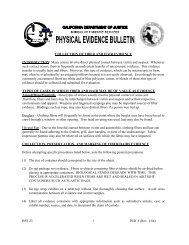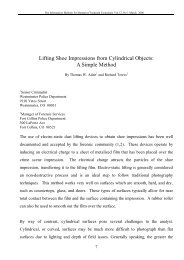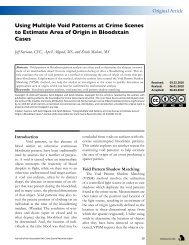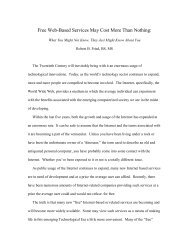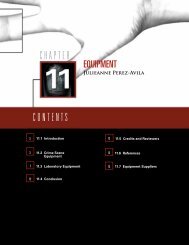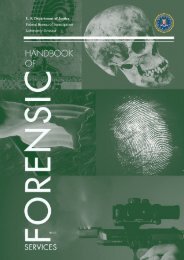PHYSICAL EVIDENCE MANUAL - Crime Scene Investigator Network
PHYSICAL EVIDENCE MANUAL - Crime Scene Investigator Network
PHYSICAL EVIDENCE MANUAL - Crime Scene Investigator Network
Create successful ePaper yourself
Turn your PDF publications into a flip-book with our unique Google optimized e-Paper software.
Physical Evidence Manual<br />
Adopted: May 2002<br />
Revisions: 6<br />
Last Revision: January 31, 2008<br />
9.0 FIBER <strong>EVIDENCE</strong><br />
Fibers are easily transferred between individuals and between individuals and<br />
environments. Fiber evidence can be of value in cases such as homicides,<br />
assaults, robberies, and burglaries. Research has shown that with few<br />
exceptions the largest quantity of fibers on an object is from the last person to be<br />
in contact with it. Therefore, it is advantageous to consider collecting fiber<br />
evidence prior to processing for other types of evidence. Caution should be used<br />
to prevent cross contamination of evidence collected for fiber examinations,<br />
particularly when crime scene personnel will also be responsible for collecting<br />
suspect or victim clothing items or for the processing of related scenes or<br />
vehicles.<br />
Laboratory analysts examine various physical, chemical, and microscopic<br />
properties of fibers when performing a comparison between evidence fibers and<br />
a potential source. Common conclusions include statements regarding the<br />
similarity or dissimilarity of the evidence fiber(s) to the possible source or<br />
standard. Fiber comparisons cannot, however, determine the source to the<br />
exclusion of all others.<br />
Fiber Examinations<br />
The following may be determined from fiber examinations:<br />
• The type of fiber (e.g. natural or synthetic, animal fiber, glass fiber, etc.)<br />
• The possible product uses for the fiber (e.g. carpet fiber, clothing fiber,<br />
etc.)<br />
• The degree of similarity between evidence fiber(s) and a fiber source<br />
Collection of Fiber Evidence<br />
Fiber evidence can be collected in a number of ways. Table 4 lists various<br />
methods and when they are appropriate.<br />
9-1



